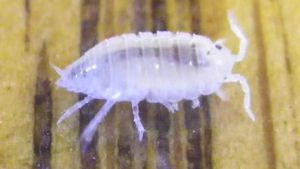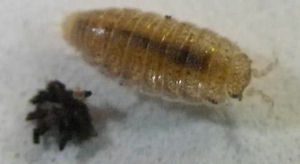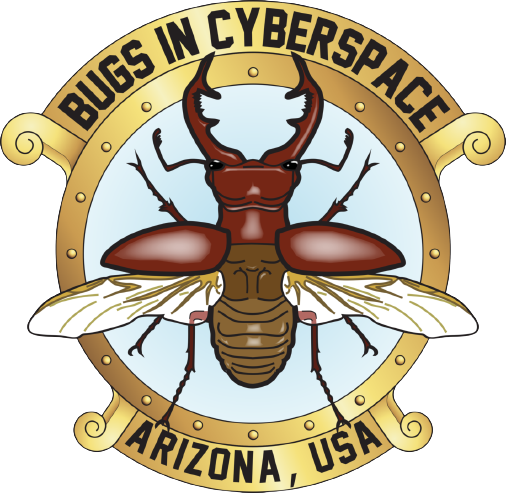Isopod Pill Bug
You can buy a variety of live pill bugs and sow bugs through our online store. Pillbugs and sowbugs are terrestrial (land) crustaceans in the taxonomic order called isopods (isopoda). Many of the species that live in backyards in the United States are originally from Europe. They are considered moderately beneficial in the sense they help break down leaves and other plant and animal remains into soil. They can occasionally become pests of greenhouses (which are unnaturally plant-rich and predator-free).
Care
Unlike many other pet bugs, isopods mature before they reach their maximum or ultimate size. They are capable of producing offspring by the time they are half grown. Cultures can easily balloon with minimal care. Keep their habitat relatively moist or humid. They enjoy having a piece of bark to hide in during the day. Many keepers provide them with egg cartons as these wick up a bit of moisture in the cage and remain moist. As omnivores they will eat bits of dog or cat food, bits of fruit and vegetable, or simply dried leaves and mosses from your backyard.
Isopods are often employed as decomposers within the pet bug, frog or reptile terrarium. Many hobbyists, from tarantula keepers, to roach and stick-insect keepers stock their cages with isopods which conveniently feed on frass (poop), leftover bits of feeder or prey insects, and pretty much anything else on or in the substrate. In this way they are often referred to as janitors. Through these clean up crew duties they go a long way to prevent the establishment of many other cage "pests" like mites and fungus gnats, as well as mold. Like a rainforest with various tiers from the upper canopy to the ground level and even slightly below it, the captive habitat can become a multi-storied, natural display with the simple introduction of these beneficial cohabitants to the cages of our other pets.
When isopods molt, they split their exoskeleton down the middle, shedding half at a time, rather than in a single piece like other familiar arthropods.
What are the differences between pill bugs and sow bugs? The most obvious difference is that pill bugs (Armadillidium spp.) can roll themselves up into tightly closed balls. Their plated segments are thick and fit together to make a perfect sphere, thereby protecting their softer underside. Sowbugs, on the other hand, are unable to roll themselves into balls. They look very similar to pill bugs, but tend to have a flatter, less hemispherical, appearance.
We have two familiar species of pills bugs in the US. Armadillidium vulgare is the larger of the two, and the dorsal segments tend to be glossy. Larger individuals of A. vulgare (older) often exhibit yellow or greenish spotting which occurs mainly down the middle of the segments. The other species we usually encounter is Armadillidium nasatum. These are smaller and tend to have a pattern of very pale green to gray spots running through the middle and along the sides of the segments. A. nasatum is also less glossy, if at all.
Sow bugs are more diverse, including several different taxonomic genera. Porcellio species sowbugs are the most familiar. Porcellio scaber is the most common and describes our most common species referred to as the gray sow bug. This same species comes in several color forms. In much the same way that different breeds of dog or cat are available in the mammalian pet trades, Porcellio scaber have been isolated into orange and other color forms. A good article that discusses some of the genetics at play can be found here.
Another common sow bug available in the hobby is Oniscus asellus. These are sometimes called skirted isopods because their segments have little extensions protruding along the perimeter of the body. Mature O. asellus have much thicker cuticles (shells) than Porcellio spp. do. This thickness, along with the rigid "skirting" makes them difficult mouthfuls for predators. Oniscus asellus are widespread in US metropolitan areas, as are the other species mentioned so far on this page. This particular species has more of a salt and pepper coloration and a glossy sheen. Occasionally, older individuals will exhibit beautiful, metallic flecks of green and yellow in sunlight or other bright light. Oniscus asellus is about 33% larger than Porcellio scaber.
A few other species proliferate in the hobby including some known as dwarf isopods or dwarf sowbugs. These other species are exotics which have not managed to establish in the US (they don't live here), like the aforementioned species. The reason for this is probably as simple as "they can't". These species originate in the amphibian hobby as feeder bugs. Sometimes called white isopods or dwarf white isopods, or even dwarf white sowbugs, Trichorhina tomentosa are an increasingly popular feeder species. The details of their anatomy are microscopic at first, and even the largest individuals barely reach 3mm. Similarly, jungle micropods, a cute name for micro isopods, reach 2mm at most. Both of these species, and a few others, are common feeders for poison arrow dart frogs and other young or even mature amphibians and reptiles. In a pinch they are also accepted by young tarantulas and mantises, especially the softer-bodied isopods.


(digital microscope photos courtesy of Ryan Eide)
Ventilation
All pets that are being housed in containers need fresh air. A little bit of air flow goes a long way in preventing the kind of habitat that promotes the growth of mold and even small mites that occasionally infest food that is left too long in millipede cages. Ventilation is achieved simply by poking holes in a container or by cutting out a section of the lid and gluing a bit of plastic or metal screen over the opening. Millipedes do not need much ventilation though, and desiccation (drying out) is the most common cause of death in captivity. If you look at your millipedes once a week, you're probably changing the air enough for them in their tank to make even having holes in the container necessary. Of course, this is partly because many shoe box types of plastic containers are not quite air-tight anyway. It is often hard to recommend a perfect tank because so many will work and there are so many different options.
Humidity
Humidity is doubly important for pet bugs. Millipedes like to drink water and they need more than a bit of environmental humidity in their habitat when the time comes for them to shed their skin. Luckily, millipedes have fewer problems molting than most other bugs. Water is offered to millipedes in two common methods. A small, shallow water dish with the addition of a few pebbles will help prevent drowning. If you don't want to spend the couple bucks for a nice looking water dish, any upside-down lid will do. Alternatively, you can just pour water into one corner of the cage every few days which really lends a more natural look to the habitat than a plastic dish anyway. The substrate will absorb most of it, but your millipedes will still be able to drink from it and benefit from the humidity that it helps their habitat to maintain. Remember that the MOST common killer of pet millipedes is lack of humidity. The substrate should always be moist in the lower depths and at least slightly moist at the top. Millipedes can dry out overnight if, for example, you were to leave them in a glass bowl in open air. If your cage has a lot of ventilation (air holes), a simple solution is to take a sheet of wax paper and pinch it between the cage/container and lid as you put the lid on. You can thin put in a few pinholes if you are worried about lack of airflow, but again, this isn't usually an issue for a pet millipede whose cage is opened at least once per week or so.
Temperature
Room temperature is just find for raising all pet millipede species, whether nymphs or adults. As with most bugs, warmer temperatures and good food supply means faster growth though. Cold temperatures lower metabolism and the millipedes will grow much more slowly. Oregon Tylobolus sp. and some polydesmid flat millipedes do tend to prefer cooler than room temperatures.
Food
One of the really great conveniences about keeping millipedes as pets is how easy they are to feed. Millipedes are omnivores, so they eat pretty much anything and everything. Everything from fruits and vegetables to bits of dried pet food are eaten but these should all be considered supplements. One of the fun parts about keeping millipedes is that you can experiment with offering them leftovers from your dinner table. Yet, always remember that the primary diet of millipedes will be their substrate.
No millipede caresheet would be complete without some mention of Archispirostreptus gigas, the African Giant Black or AGB millipede. This once popular hobby species is nolonger imported into the US on account of the commensal (symbiotic) mites that live on them in their native habitat, and which proved to be damaging to certain agricultural crops in countries where they were imported as pets. Captive bred specimens occasionally surface in the US hobby, but this species was never a very good reproducer in captivity. They lived upwards of a decade and care was simple, but alas we speak of them mostly in the past tense now. Fortunately, captive bred specimens do not carry the commensal mites as this long dead specimen from my video below "naturally" did.
